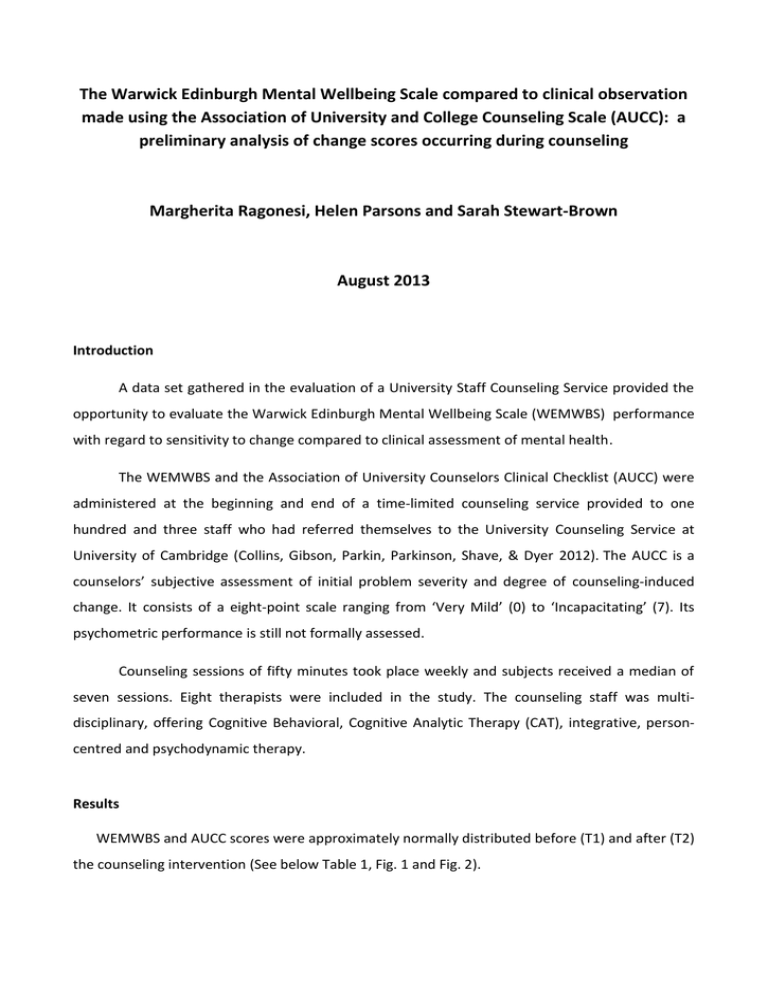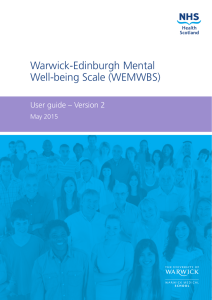The Warwick Edinburgh Mental Wellbeing Scale compared to clinical observation
advertisement

The Warwick Edinburgh Mental Wellbeing Scale compared to clinical observation made using the Association of University and College Counseling Scale (AUCC): a preliminary analysis of change scores occurring during counseling Margherita Ragonesi, Helen Parsons and Sarah Stewart-Brown August 2013 Introduction A data set gathered in the evaluation of a University Staff Counseling Service provided the opportunity to evaluate the Warwick Edinburgh Mental Wellbeing Scale (WEMWBS) performance with regard to sensitivity to change compared to clinical assessment of mental health. The WEMWBS and the Association of University Counselors Clinical Checklist (AUCC) were administered at the beginning and end of a time-limited counseling service provided to one hundred and three staff who had referred themselves to the University Counseling Service at University of Cambridge (Collins, Gibson, Parkin, Parkinson, Shave, & Dyer 2012). The AUCC is a counselors’ subjective assessment of initial problem severity and degree of counseling-induced change. It consists of a eight-point scale ranging from ‘Very Mild’ (0) to ‘Incapacitating’ (7). Its psychometric performance is still not formally assessed. Counseling sessions of fifty minutes took place weekly and subjects received a median of seven sessions. Eight therapists were included in the study. The counseling staff was multidisciplinary, offering Cognitive Behavioral, Cognitive Analytic Therapy (CAT), integrative, personcentred and psychodynamic therapy. Results WEMWBS and AUCC scores were approximately normally distributed before (T1) and after (T2) the counseling intervention (See below Table 1, Fig. 1 and Fig. 2). Table 1: Mean, median, skewness, kurtosis, minimum and maximum score of WEMWBS and AUCC at both T1 and T2 Valid WEMWBS Total WEMWBS Total AUCC Severity AUCC Severity Score at T1 Score at T2 T1 T2 103 103 103 103 0 0 0 0 Mean 39,88 49,29 4,17 2,13 Median 40,00 50,00 4,00 2,00 Skewness ,139 ,009 -,009 ,276 Std. Error of Skewness ,238 ,238 ,238 ,238 Kurtosis ,940 ,419 -,623 -,498 Std. Error of Kurtosis ,472 ,472 ,472 ,472 Minimum 18 29 3 0 Maximum 61 70 6 5 N Missing Fig. 1: Score distributions for WEMWBS at both T1 and T2 Fig. 2: Score distributions for AUCC at both T1 and T2 Mean scores before (T1) and after (T2) the intervention on both scales (WEMWBS, M = 39.88 at T1 and 49.29 at T2 and AUCC M = 4.17 at T1 and M = 2.13 at T2) indicate an improvement in mental health. The WEMWBS maximum and minimum scores at T1 were 18 and 61, and 29 and 71 at T2. The AUCC scores range from 3 to 6 at T1 and 0 to 5 at T2. Change scores from T1 to T2 were examined for both scales (See below Table 2, Fig. 3). Table 2: Mean, median, skewness, kurtosis, minimum and maximum score of WEMWBS and AUCC change scores at both T1 and T2 WEMWBS change scores AUCC change scores (difference in scores (difference in scores between WEMWBS Total between AUCC Severity at Score at T2 and T2 and AUCC Severity at WWMWBS Total Score at T1) T1) Valid 103 103 0 0 9,41 -2,03 Median 10,00 -2,00 Skewness -,363 -,070 Std. Error of Skewness ,238 ,238 Kurtosis ,561 -,329 Std. Error of Kurtosis ,472 ,472 Minimum -15 -4 Maximum 26 0 N Missing Mean Fig. 3: Score distributions for WEMWBS and AUCC change scores Improvements in WEMWBS scores are indicated by positive numbers, in contrast improvements in AUCC scores are shown by negative numbers. Differences in WEMWBS and AUCC scores were approximately normally distributed. The differences in WEMWBS scores range from 15 to 26 and differences in AUCC scores range from 0 to – 4. Table 3: Frequency of AUCC change scores Frequency Percent Valid Percent Cumulative Percent -4 7 6,8 6,8 6,8 -3 24 23,3 23,3 30,1 -2 42 40,8 40,8 70,9 -1 25 24,3 24,3 95,1 0 5 4,9 4,9 100,0 103 100,0 100,0 Valid Total Table . 4: Mean and minimum and maximum scores of WEMWBS for each category of AUCC change scores N Mean Std. Deviation Std. Error 95% Confidence Interval for Mean Lower Bound Minimum Maximum Upper Bound -4 7 13,43 8,304 3,139 5,75 21,11 -2 22 -3 24 11,71 6,843 1,397 8,82 14,60 3 23 -2 42 8,07 7,566 1,167 5,71 10,43 -15 19 -1 25 10,00 6,455 1,291 7,34 12,66 0 26 0 5 1,00 7,906 3,536 -8,82 10,82 -5 14 103 9,41 7,518 ,741 7,94 10,88 -15 26 Total Fig. 4: Box plot of WEMWBS change scores against AUCC change scores A correlation is evident with those who registered a clear improvement (-4) or no improvement (0) on the AUCC scale and the WEMWBS. There was little difference in change scores on WEMWBS for those improving by 1, 2 or 3 points on the AUCC scale. Table 5: ANOVA of WEMWBS change scores against AUCC change scores and its test of homogeneity of variances (Leven Statistic) Sum of Squares Between Groups df Mean Square F 677,415 4 169,354 Within Groups 5087,458 98 51,913 Total 5764,874 102 Levene Statistic ,410 df1 df2 4 3,262 Sig. ,015 Sig. 98 ,801 The homogeneity of variance assumption for ANOVA test may be reasonably satisfied (See Leven Statistic in Fig. 5). There is sufficient evidence that the variances are not equal (p value is .801). The one-way, between-subjects analysis of variance reveals a reliable effect of the levels of “AUCC change scores” on “WEMWBS change scores”, F (4, 98) = 3.262, p = .015, MSerror = 51.913, α = .05 (Fig. 5). Table . 6: Multiple comparisons between WEMWBS change scores and AUCC change scores, Bonferroni post-hoc test Dependent Variable: WEMWBS change scores (I) AUCC change scores (J) AUCC change scores Mean Difference Std. Error Sig. (I-J) 95% Confidence Interval Lower Bound Upper Bound -3 1,720 3,095 1,000 -7,17 10,61 -2 5,357 2,941 ,716 -3,09 13,80 -1 3,429 3,081 1,000 -5,42 12,28 * 4,219 ,040 ,31 24,55 -4 -1,720 3,095 1,000 -10,61 7,17 -2 3,637 1,844 ,514 -1,66 8,93 -1 1,708 2,059 1,000 -4,21 7,62 * 3,542 ,032 ,54 20,88 -4 -5,357 2,941 ,716 -13,80 3,09 -3 -3,637 1,844 ,514 -8,93 1,66 -1 -1,929 1,820 1,000 -7,16 3,30 0 7,071 3,409 ,406 -2,72 16,86 -4 -3,429 3,081 1,000 -12,28 5,42 -3 -1,708 2,059 1,000 -7,62 4,21 -2 1,929 1,820 1,000 -3,30 7,16 0 9,000 3,530 ,123 -1,14 19,14 4,219 ,040 -24,55 -,31 -4 0 -3 0 -2 -1 12,429 10,708 -4 -12,429 * -3 -10,708 * 3,542 ,032 -20,88 -,54 -2 -7,071 3,409 ,406 -16,86 2,72 -1 -9,000 3,530 ,123 -19,14 1,14 0 *. The mean difference is significant at the 0.05 level. Multiple comparisons show only two statistically different comparisons (-4 and 0; -3 and 0). This is likely to be due to wide confidence intervals because of the relatively small sample size, rather than differences in means (see the underlined column on the right-hand-side in the pairwise differences tables) (Fig. 6). Except for the comparison -2 vs -1, the data reported above show a trend where improvements in AUCC scale correspond to improvements in WEMWBS scale. This is illustrated in a graph showing WEMWBS change on the Y axis and AUCC change on the X axis (See the graph below). Figure 5: Change on WEMWBS score and change in AUCC severity score Conclusions These analyses suggest WEMWBS is sensitive to improvements in mental wellbeing as observed by clinicians but not to differences between small and moderate clinically detectable change. The analyses need repeating in a larger sample to substantiation these findings Acknowledgements We are very grateful to Jill Collins and Colin Dyer for allowing further analysis of their dataset and to all the clinicians and their clients who collected the data.



